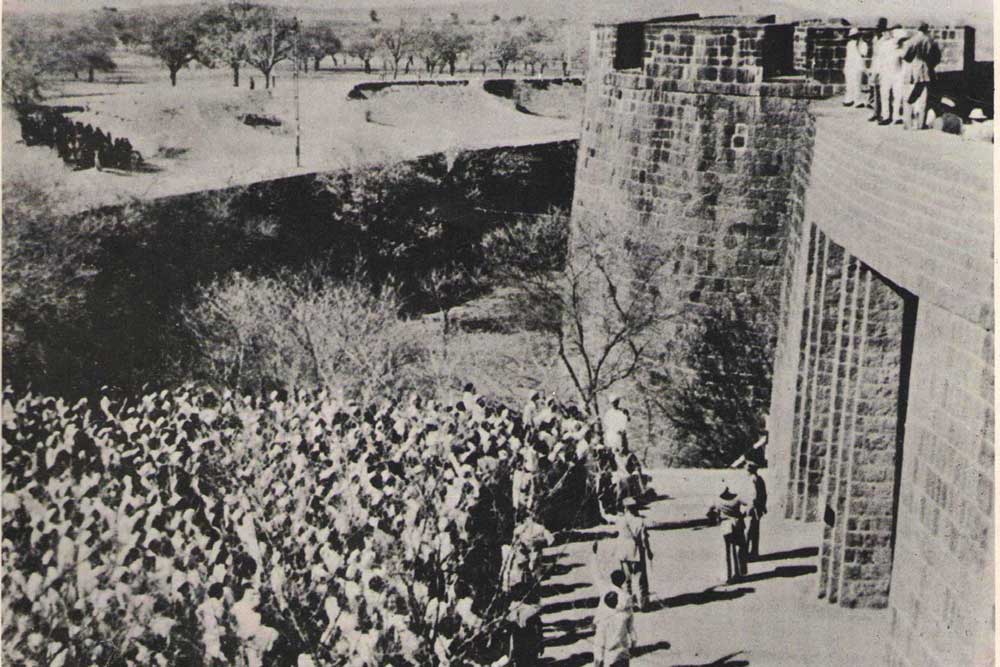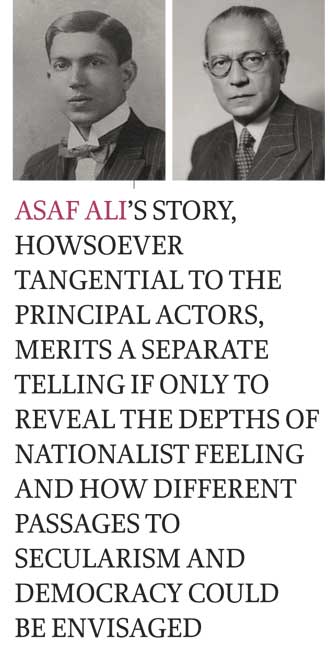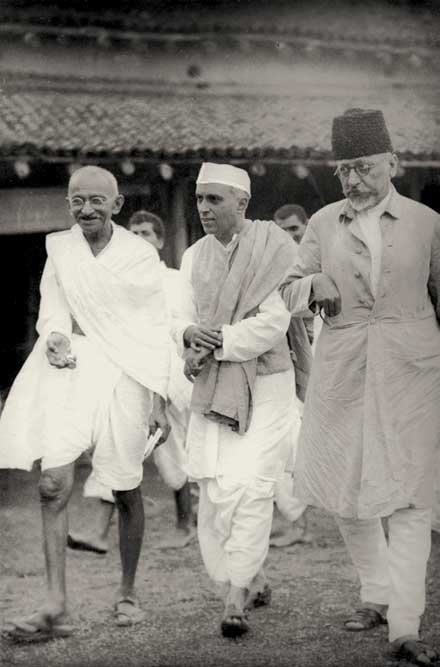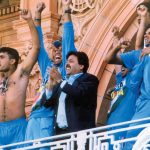The End of Inevitability
The linear narrative of India’s freedom struggle and its unrealised possibilities
 TCA Raghavan
TCA Raghavan
 TCA Raghavan
TCA Raghavan
 |
24 Dec, 2021
|
24 Dec, 2021
/wp-content/uploads/2021/12/Inevitability1.jpg)
A stamp sheet from 2017 commemorating the 75th anniversary of the Quit India Movement
CONVENTIONAL WISDOM has it that there is a linear trajectory to India’s freedom movement. The gradual spread of the spirit of nationalism had clearly identifiable markers starting with the partition of Bengal in 1905, followed by Jallianwala Bagh in 1919, then the non-cooperation and civil disobedience movements of the 1920s and 1930s down to the Quit India resolution in 1942, climaxing finally in freedom in 1947. Nationalism on this trajectory evolves from being an elite preoccupation to mass politics and the culmination of that evolutionary process is the final ejection of the British.
This linear trajectory is not wrong nor even incomplete or partial for it approximates to reality about as closely as any generalisation can. Yet, alongside the standard narrative there is also to be plotted a parallel trajectory of communalism and separatism, culminating in the bloodbath of Partition that accompanied Independence. Here too, the markers are clearly identifiable—the formation of the Muslim League in 1906, the communal outbreaks that accompanied each phase of the freedom struggle, the Pakistan Resolution of the Muslim League of 1940 and Direct Action Day in 1946, amongst others.
Possibly when we put both trajectories together, we see how jagged a chronicle our history presents itself as. Tangential views from people less known, present when decisions we ascribe solely to the well-known stalwarts were made, give us a glimpse of the internal tensions within dominant narratives or even of the remoter possibilities that never really could materialise. Such views occasionally also reveal how contingent, how tentative and how fragile the dominant narratives that shape our readings of the past are.
We get a set of such tangential views from a somewhat exceptional setting in 1942. An old Nizamshahi fortress in Ahmednagar was the site of an unusual enforced gathering for over 30 months. Incarcerated in it was the entire Congress Working Committee (CWC), in effect the bulk of the nationalist leadership. They had been arrested in Bombay on August 9th, 1942—soon after the resolution that would come to be known as “Quit India” was adopted. In Ahmednagar fort, from August 1942 till March 1945—when the CWC was split up and dispersed to jails in the respective home provinces of each member—the Congress leadership, therefore, was without direct contact with the outside world. Mahatma Gandhi too was arrested and jailed, but he was incarcerated in Poona in the Aga Khan’s palace which was temporarily converted into a prison.
Arresting the Congress leadership had been planned for some time. For the British with their backs to the wall, the Congress attitude represented a stab in the back—to the official mind, the Congress leadership needed to be taught a lesson. Various suggestions for their incarceration had therefore been considered: Aden, Uganda and the Sudan were weighed before being finally discarded as being less than pragmatic. Options in India were then deliberated, and Attock at the confluence of the Indus and the Kabul rivers was given up in favour of Ahmednagar in the Deccan.
A special train took the group from Bombay through deserted stations where even railway staff were not allowed in. The only halt en route was at Poona where the Mahatma and his immediate party were made to alight. Once it was confirmed to the rest of them that their destination was the Ahmednagar fortress, some of the leaders felt their historical imagination kindle. To Maulana Azad, the fort brought to mind “several forgotten footprints of time”. As they neared the fort and its ramparts became visible, Azad looked to see if he could identify its moat as had been described by Abul Fazl and later by General Wellesley, in time more famous as the Duke of Wellington. Azad could not spot the moat and wondered if it had been filled in the past century-and-a-half. Asaf Ali’s thoughts also turned to history: “Aurangzeb’s grave is scarcely fifty miles from here. And I often say to myself: ‘And the Mughal empire was buried with him’. It is a strange coincidence that, sitting in this fortress prison of Ahmednagar we are witnessing the guttering of the British power’s candle…The Union Jack is daily hosted on the bastion which faces us. I say to myself ‘This is the last of it. It cannot float in India after this now’.”
The prisoners numbered twelve in all with ages ranging from the early forties to the late sixties. The three obvious leaders were Jawaharlal Nehru, Vallabhbhai Patel and Azad, the last then being the president of Congress. GB Pant came next in the hierarchy, possibly because he had been premier of the United Provinces under the government formed in 1937. The others included Asaf Ali from Delhi, Syed Mahmud from Bihar, Shakarrao Deo from Maharashtra, Prafulla Ghosh from Bengal, JB Kripalani from Sindh (officially at least, although he had not lived there for a long time), Hare Krishna Mahtab from Orissa, Narendra Deva from the United Provinces and Pattabhi Sitaramayya from Madras, an early votary of a separate Andhra province. While each of them knew the others through political activity and Congress party meetings had brought them together frequently, nevertheless, almost two-and-a-half years together in a confined space meant an unusual intimacy. But it also brought its own set of frictions and tensions. This was not the first experience of prison for any of them but it was possibly the longest for most, although Azad had been in prison from 1916 to 1920. It was also perhaps the most rigorous in terms of tightly controlled contact with the outside world. Perimeter security and insulating the prisoners from the outside world were entrusted to the custodians of the fort—the Army. The internal administration of the makeshift prison was the responsibility of the Bombay government which acted on even the smallest of issues only with the specific go-ahead of the Government of India.

During the initial settling down, each step forward meant brushes with the authorities. This was not so much with their jailer, “a poor creature”, who was in Pattabhi Sitaramayya’s words “half timid and half awe struck”, but with the deputy commissioner of the district and the inspector general of prisons, who would in turn only act on instructions from New Delhi relayed by the Bombay government. Each of the Congress leaders, even more so collectively, were however at their best in brushes with authority, no matter what the brush was. On arrival, the jailor “served them a heapful of bread and butter in a ‘Thali’”. This was “promptly refused unless served in trays and accompanied by cups and saucers, spoons and forks, kettles and cutlery”. The demand was conceded and the process of settling down began.
In the early weeks of imprisonment an internal order was established. First, the food and the menu had to be improved. A number of convicts from the Ahmednagar jail had been provided by the administration to act as helpers, but they turned over rapidly and needed supervision. Looking after a group of important politicians was not their core competence. There were other pastimes—gardening and badminton, for instance, and many of the prisoners took an enthusiastic interest in both. The entire party understood the importance of joint endeavour and daily routines, and a kind of cooperative balance soon came into effect.
Over time newspapers, books and letters, after being censored, would be allowed. With newspapers trickled in information from outside of the violence that had taken place countrywide as news had broken of the arrests of the nationalist leadership. Asaf Ali wrote on September 2nd, 1942: “I was moved to the very depths of my being when I learnt last night that Delhi was in the grip of an upheaval of anger for several days. Hell, it seems, was let loose almost at the start, when the police shot dead 12 demonstrators and injured God knows how many…Is it a wonder that the result was counter violence by the people?” The fact also is that at the CWC meeting before the arrests and crackdown, Asaf was in a minority against taking any precipitate action which the resolution adopted could be seen as. But he also saw clearly the responsibility of the government in mishandling the whole situation: “Did they not know that by putting a match to the powder magazine of public resentment and by shutting up precisely those persons who constitute a veritable fire brigade, they would sabotage the very war effort they were so concerned about….”
But this was not in any way a pleasant, if forced, holiday. Many of the prisoners were not in good health and the prolonged incarceration meant further deterioration. Medical attention was minimal—their jailor-cum-doctor, in most cases, the only recourse. Anything needing more specialised attention required clearance from the Government of India after the Bombay government had given its recommendations. Proposals for examination by a specialist were scrutinised minutely on file, some of which fortunately survive if only to establish how little government functioning has changed. The long period of incarceration was also an extraordinarily stressful experience for all of them, cut off as they were from their families and their political bases. Azad’s wife died while he was in custody and the news was conveyed to him only after a delay of some days. Kasturba Gandhi died at the Aga Khan Palace prison, as did Mahadev Desai. Asaf Ali himself was in a deep depression for long periods; the cause was in large part worry about his wife Aruna Asaf Ali who, in defiance of the Congress way of doing things, evaded arrest and went underground and remained so with a bounty for her arrest till the war ended.

And yet, this enforced seclusion was also for some an extraordinarily creative period. Jawaharlal Nehru penned his famous Discovery of India. Azad, Asaf Ali, Narendra Deva corrected his drafts on some points. Azad wrote a collection of letters later published as Ghubar-e-Khatir that also remains a classic. Narendra Deva delved deep into the intricacies of Buddhist philosophy and Sitaramayya sought to update his History of the Indian National Congress for a new edition. He found time also to keep a voluminous diary—a witty and amused glance at their life together in prison, to be published later as Feathers and Stones.
Asaf Ali also wrote many pages on his prison experience, reflected on his times and put together a part autobiography.
Yet all these and other activities were pastimes, to break the monotony, to have a rhythm and a repetitive pattern to keep sane in a situation of enforced inactivity and being totally removed from their otherwise hectic daily pace of life. What had brought the group together to Ahmedanagar was the national struggle for independence and this remained the main issue throughout the long period of imprisonment. The working committee, although it put up a united front, was internally riven with differences on a whole range of issues. This was not surprising in itself—Congress had always been a broad church and within it there were different perspectives, ideologies and personalities constantly battling for precedence. The Quit India resolution had seen the CWC present a united face in public but there were deep and major differences within. The Congress-led provincial governments had resigned in October 1939 on the grounds that India was not consulted before Britain made it a party to the war against Germany in Europe. The real point of contention was Congress wanted a clear commitment from the British on India’s sovereignty and freedom after the war. Such an assurance was not forthcoming and so despite the private sympathy many in India felt, and possibly the entire working committee shared, for Britain’s predicament with its back to the wall against Germany, the seeds of confrontation between Congress and the colonial Government had already germinated. The British had made a fatal miscalculation as far as India’s position in the war was concerned. By dispensing with even a formulaic consultation process with the elected bodies in India, and not backing down from this position, it narrowed the options for Congress and pushed it, much against the will of many Congressmen, into more confrontational positions. Some prominent Congress leaders, in particular C Rajagopalachari, tried hard to resist this turn to agitation. Asaf Ali himself had much sympathy for this approach: “I have remained a Swarajist all the time, that is, a believer in the parliamentary procedure”. This was a diary entry in August 1943 after a year of imprisonment. A year later in August 1944, now after two years of imprisonment, his views were no different—the confrontational path adopted by Congress at Gandhi’s instance was a mistake: “In my opinion 1942 was a wrong occasion. The entire war period should have been devoted to parliamentary activity…In the end would have come the award—or otherwise a struggle. But Gandhiji and his group precipitated a crisis prematurely and Jawaharlal simply abdicated his reason. And now we are in a ’quandary’.”

These differences within the CWC were not new and they persisted through the period of imprisonment. The dividing lines were also clear. Azad, Asaf and Syed Mahmud formed one group. The others were led by Patel and included Shakarrao and Prafulla Ghosh. The remaining balance of those in custody, such as Pant, Sitaramayya and others, would generally follow Nehru and it was to him that Azad and his supporters looked to for getting the CWC to moderate its position.
In Asaf Ali’s telling, Maulana Azad came to the conclusion in November 1943 that something needed to be done. A change in incumbency had taken place in New Delhi with Archibald Wavell now the new Viceroy. Azad felt that the time was ripe for the CWC to write to the Government and start a process. In Asaf’s account, the terms of the communication would be that in view of the terrible famine conditions in Bengal and the Government’s resolve to carry the war to the Japanese-occupied territories, the working committee was prepared to forget the past and cooperate with the Government. The idea was broached to Nehru and Patel first, who were not opposed to it per se but wanted the new Viceroy to take the first step. Therefore, they, according to Asaf, “hummed and hawed”. Azad thereafter convened, or rather gathered together in the largest room available, all the CWC members for a discussion that began on November 15th and went on for about a week. The outcome was predictable—Patel opposed and Nehru was lukewarm to the idea. There was no real chance of securing the outcome Azad wanted. The long consultation was often acrimonious and heated. The differences evidently were not tactical but much deeper and at multiple levels.
In addition, there were personalities and likes and dislikes. Asaf wrote about Patel: “He seems to consider everyone who does not agree with his point of view as a sort of delinquent”. Nehru, similarly, despite his enormous respect for Maulana Azad, was to write: “I always feel at a slight disadvantage in discussing anything with him. I cannot adopt my usual free and easy manner as this might rub him up the wrong way…He has an astonishing mental grasp and a prodigious memory…But the 18th and 19th centuries cling to him.” Nehru was also, for example, to describe Prafulla Chandra Ghosh’s irritating manner: “he smiles at the wrong moment and appears to look around for applause”. The fact is that enforced inactivity in close proximity obviously fostered its own tensions and frictions. Asaf had written: “When human beings are imprisoned together for a long time they cannot help jarring on one another particularly if they are ill assorted temperamentally and by cultural background”.
The real problem lay not in personalities or in Gandhi’s excessive influence but in different approaches to the situation. What concerned Maulana Azad was the state of Hindu-Muslim relations
For some in the CWC to embark on a new line without Gandhi’s explicit approval verged on a kind of heresy. This group included Patel, Ghosh, Shankarrao and perhaps others too. In Nehru’s words, “To criticize any step taken by Bapu is lese majeste. That is the hiatus between the so called Gandhi members of the WC and the others”. Thus, Asaf was to write, “Patel and the others rely on Gandhi to do everything for them”. About Nehru, he similarly felt that notwithstanding the power of his analysis which made him disagree with Gandhi, in the end he would fall in line.
The real problem lay of course not in personalities or in Gandhi’s excessive influence but in different approaches to the situation that emerged after the resignation of the Congress ministries in 1939. What concerned Azad—and Asaf Ali and Syed Mahmud who supported him—was the state of Hindu-Muslim relations, the limited outreach of Congress among Muslims, and the growing strength of the League which was free to operate while Congress was locked up. In their thinking, this was the real challenge for Congress.
Since the Cripps Mission one concept that had generated much discussion was that of ‘self-determination’ for the Muslim majority provinces. In Asaf’s view, this new reality had to be faced. “Nothing is easier for me,” he wrote to himself in March 1944, “than to prove that Pakistan is the most undesirable for India as a whole and for the Indian Muslims. But if we refuse to have anything but the best the situation may get worse. In the evolving world we have often to be content with the second or next best”. To him, therefore, if this indeed was inevitable, recognition of the principle of self-determination was preferable to a union that was forced. “If there is to be a Pakistan, a treaty will have to be negotiated by it with Hindustan”. The issue itself was not a new one.
Rajagopalachari had been saying much the same thing in earlier Congress sessions and had been largely isolated on the issue—with the Mahatma, Nehru and Patel all opposing him, leading finally to his resigning from Congress.
But for Asaf, in discussions with Nehru, the different ways this issue could be looked at in future also became clear. “Jawaharlal made it clear in the end that the big economic plan by which he intended to tackle the problem of India’s poverty would not be realizable if the communal tangle continued to come in the way. And therefore he would rather agree, of course unwillingly, to let the Muslims separate where they could. He would then have a strong central government in the rest of India and proceed with his economic programme”.
Others were more suspicious about Asaf talking about an Indian confederation or a commonwealth with provinces having the right to secede. One diary entry is: “My talk with Vallabhbhai on my idea of a Commonwealth of India has travelled in some form to the different ‘clubs’ here. Jawaharlal brought the news to the Maulana that I [Asaf] was described as going one better than Jinnah”. Asaf commented: “There is no limit to narrowness, suspicion and a fanatical adherence to the idea that only that political structures which some of these gentlemen have in view is the best [sic]”. But reactions on this issue had the potential to become truly acrimonious and Asaf’s discussions with other CWC members brought out just how deep waters were on the Hindu-Muslim issue.
“Some six months ago when I spoke in similar terms to Narendra Dev, he held that the principle of self determination could not be permitted to be exercised by anybody except by the population of India as a whole. He further said that those who thought along these lines—we were talking of Muslims—would have to be ‘driven out’ of India. I stopped the talk with the rejoinder ‘Try it”. Since then I have not discussed politics with him.”
Asaf Ali would go on to serve as a minister in the interim government, as India’s first ambassador to the US and as governor of Orissa. He died in April 1953 when ambassador in Switzerland. His story, howsoever tangential to the principal actors, merits a separate telling if only to reveal the depths of nationalist feeling which the freedom struggle generated and how different passages to secularism and democracy could be envisaged.
Of that fateful period in prison all that survives are impressions in some diaries or some memories and reflections recorded in a few autobiographies. These convey a sense, however disjointed, of the debates as they happened on India’s future. In Ahmednagar fort itself these discussions had an extra intensity, even some pathos. The diary outpourings they reflect themselves as are of participants in the midst of a churn trying hard to rise above it to see with clarity the conjuncture they were embedded in. Clarity amid participation is the rarest of creatures.
With the passage of time and the benefit of hindsight, it is sometimes all too easy to critique these different perspectives for consistency, or even pass judgment about foresight, motive and integrity. These debates resonate with us however for two reasons. First and obvious, because these are also about roads not taken and possibilities left unexplored. This is not surprising in itself—every conjuncture has more than one outcome. There is no inevitability to anything. Choices therefore are for real and outcomes are the result of choices exercised. Second, and equally obvious, these issues are those we grapple with still. They are not precisely the same but at the core there are similarities between the past and the present. In that sense all history is truly contemporary.
And yet, to be engrossed with the past for only these reasons would be also to devalue it. What clearly is also important is how a group of a dozen nationalist leaders were incarcerated in a mediaeval fortress for a considerable length of time when the world around them was fundamentally changing. That human drama, even when shorn of all the high politics of the age and of all our contemporary takeaways, is in many ways the truest history and to be valued for its own sake.

/wp-content/uploads/2025/07/Cover-Shubman-Gill-1.jpg)












More Columns
Shubhanshu Shukla Return Date Set For July 14 Open
Rhythm Streets Aditya Mani Jha
Mumbai’s Glazed Memories Shaikh Ayaz